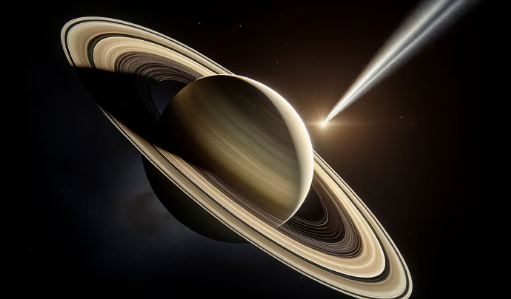Saturn Ejects Comet A117uUD into Interstellar Space
In 2024, scientists made a significant discovery when they announced that comet A117uUD had been ejected from our solar system after a close encounter with Saturn.
Discovery of Comet A117uUD
The comet, A117uUD, was discovered by the Asteroid Terrestrial-impact Last Alert System (ATLAS) on June 14, 2024. Researchers studied its path around the Sun using 142 tracking observations.
Impact of Saturn’s Gravity
In 2022, A117uUD had a close encounter with Saturn. The planet’s strong gravity changed the comet’s path, sending it into a very elongated orbit and eventually ejecting it from the solar system at a speed of about 10,800 km/h. This event is only the second time scientists have documented a comet being thrown out of the solar system by a planet’s gravity. The first time was with Comet C/1980 E1 (Bowell) and Jupiter in 1980.
Insights from the Ejection
Studying A117uUD’s path provides valuable insights into how gravity affects objects in space. This event suggests that comet ejections might happen more often than previously thought, challenging the idea that they are rare. As A117uUD travels into interstellar space, it joins a growing list of objects from outside our solar system, helping scientists learn more about space mechanics and the chances of future encounters with similar objects.
Role of ATLAS
The ATLAS system played a crucial role in discovering and monitoring A117uUD, highlighting its importance in expanding our knowledge of the solar system and unusual celestial events. Scientists will continue to observe A117uUD to uncover more mysteries about our solar system and prepare for possible future encounters with interstellar objects.
Saturn Facts:
- Size and Rings: Saturn is the second-largest planet in our solar system, famous for its spectacular rings made of ice and rock.
- Moons: It has 83 confirmed moons, with Titan being larger than the planet Mercury.
- Winds: Saturn’s winds can reach speeds of 1,100 miles per hour.
- Composition: It is a gas giant primarily made of hydrogen and helium.
- Density: Despite its size, Saturn is so light that it could float in water.
- Color: The planet’s yellowish color comes from ammonia crystals in its atmosphere.
Month: Current Affairs - August, 2024
Category: Science & Technology Current Affairs







